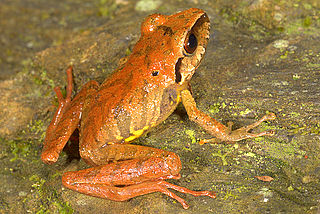Rulyrana spiculata is a species of frog in the family Centrolenidae. It is endemic to the eastern slopes of Andes in central and southern Peru and northern Bolivia. Common name Cuzco Cochran frog has been coined for it.

Hyalinobatrachium pellucidum, also known as the Rio Azuela glass frog, is a species of frog in the family Centrolenidae. It is found in lower montane rainforests on the Amazonian Andean slopes in Ecuador and Peru. The specific name pellucidum is Latin for "transparent" and refers to the transparent parietal peritoneum of this species.
Hyloscirtus alytolylax, called the babbling stream frog, babbling torrenter, or tadapi tree frog in English, is a species of frog in the family Hylidae found in Colombia and Ecuador. Its natural habitats are subtropical or tropical moist lowland forests, subtropical or tropical moist montane forests, and rivers. It is threatened by habitat loss. Scientists have observed it in Colombia between 500 and 2159 meters above sea level and in Ecuador between 400 and 2000 meters above sea level.
Linda's tree frog is a species of frog in the family Hylidae found in Colombia and Ecuador between 2000 and 2500 meters above sea level. Its natural habitats are subtropical or tropical moist montane forests, rivers, pastureland, rural gardens, and heavily degraded former forests. It is threatened by habitat loss.
The Morona-Santiago tree frog is a species of frog in the family Hylidae endemic to Ecuador. Its natural habitats are subtropical or tropical moist montane forests and rivers. Scientists have seen it between 2225 and 2350 meters above sea level. It is threatened by habitat loss.
The Rio Chingual Valley tree frog is a species of frog in the family Hylidae found in Colombia and Ecuador. Its natural habitats are subtropical or tropical moist montane forests, rivers, and heavily degraded former forests. Scientists have seen it between 1950 and 2700 meters above sea level.
The Papallacta tree frog is a species of frog in the family Hylidae found in Colombia and Ecuador. Its natural habitats are subtropical or tropical moist montane forests and rivers. Scientists have seen it between 1950 and 2660 meters above sea level in the Cordillera Oriental. It is threatened by habitat loss.
Sarcohyla celata, also known as the Oaxaca treefrog, is a species of frog in the family Hylidae. It is endemic to Mexico and only known from the Sierra de Juárez in northern Oaxaca. After having not been seen after 1984, it was feared that the species might be extinct. However, the species was rediscovered in field surveys during 2011–2014 and some subpopulations are at healthy levels.
Sarcohyla charadricola is a species of frogs in the family Hylidae.
Plectrohyla pokomchi is a species of frogs in the family Hylidae. It is endemic to central and eastern Guatemala and known from Sierra de Xucaneb and Sierra de las Minas at elevations of 1,400–1,900 m (4,600–6,200 ft) above sea level. Its specific name refers to the Poqomchi' people, a group of Indian people from the Guatemalan highlands. Common name Rio Sananja spikethumb frog has been coined for it.
Sarcohyla psarosema is a species of frogs in the family Hylidae.
Sarcohyla sabrina, also known as the Sierra Juarez treefrog, is a species of frog in the family Hylidae. It is endemic to the northern slopes of Sierra de Juárez in northern Oaxaca, Mexico. The specific name sabrina is Latin for river nymph and refers to the close association of this species with streams.
Sarcohyla siopela, also known as the voiceless treefrog or mute treefrog, is a species of frog in the family Hylidae. It is endemic to Mexico and only known from the west slope of the Cofre de Perote Mountain, in Sierra Madre Oriental, central Veracruz. It is feared that the species might be extinct.
Pristimantis ceuthospilus is a species of frog in the family Strabomantidae. It is endemic to northern Peru and occurs on the western slopes of the Cordillera de Huancabamba and the Pacific slope of the Cordillera Occidental. There are also as yet unconfirmed records from southern Ecuador. The specific name ceuthospilus, from Greek keuthos ("hidden") and spilos ("spot"), refers to the yellow spots in the groin and thighs that remain hidden when the frog is sitting. Common name Wild's robber frog has been coined for it.

Pristimantis danae is a species of frog in the family Strabomantidae, sometimes known as Cuzco robber frog. It is found in the Andes between southern Peru and north-western Bolivia. It is named after the daughter of the author, Dana K. Duellman, who helped in collecting the frogs. Pristimantis reichlei, described in 2009, was previously confused with Pristimantis danae.
Cornufer browni is a species of frog in the family Ceratobatrachidae. It is endemic to Papua New Guinea. It has been observed between 100 and 200 meters above sea level and between 1100 and 1300 meters above sea level.

Platymantis guentheri is a species of frog in the family Ceratobatrachidae. It is endemic to the Philippines, where it occurs in the rainforests of Leyte, Biliran, Maripipi, Bohol, Panglao, Dinagat, and Mindanao islands. Its natural habitats are subtropical or tropical moist lowland forest, subtropical or tropical moist montane forest, plantations, rural gardens, and heavily degraded former forest. It has been observed as high as 700 meters above sea level.
Pseudophilautus mittermeieri, commonly known as Mittermeier's shrub frog, is a species of frog in the family Rhacophoridae. It is endemic to Sri Lanka.
Sarcohyla miahuatlanensis, or the Sierra Miahuatlan spikethumb frog, is a species of frog in the family Hylidae. It is endemic to Mexico and only known from its type locality near Candelaria Loxicha on the Sierra de Miahuatlán in Oaxaca.
Pseudophilautus jagathgunawardanai is a species of frogs in the family Rhacophoridae, endemic to Sri Lanka.



